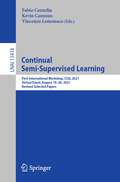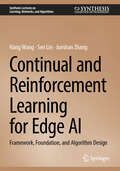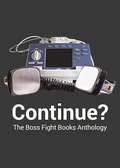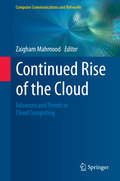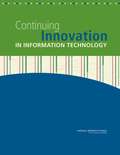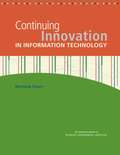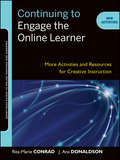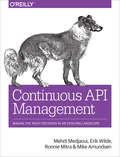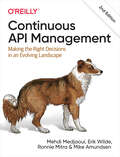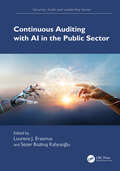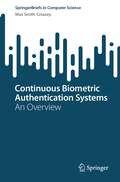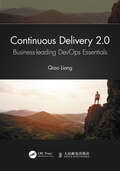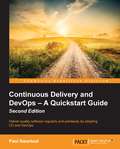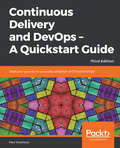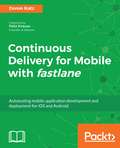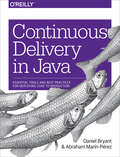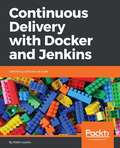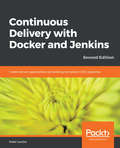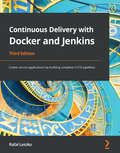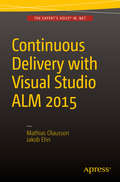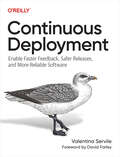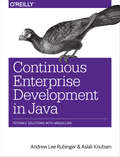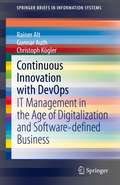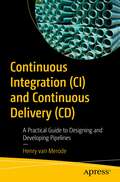- Table View
- List View
Continual Semi-Supervised Learning: First International Workshop, CSSL 2021, Virtual Event, August 19–20, 2021, Revised Selected Papers (Lecture Notes in Computer Science #13418)
by Fabio Cuzzolin Kevin Cannons Vincenzo LomonacoThis book constitutes the proceedings of the First International Workshop on Continual Semi-Supervised Learning, CSSL 2021, which took place as a virtual event during August 2021.The 9 full papers and 0 short papers included in this book were carefully reviewed and selected from 14 submissions.
Continual and Reinforcement Learning for Edge AI: Framework, Foundation, and Algorithm Design (Synthesis Lectures on Learning, Networks, and Algorithms)
by Junshan Zhang Sen Lin Hang WangThis book provides a comprehensive introduction to continual and reinforcement learning for edge AI, which investigates how to build an AI agent that can continuously solve new learning tasks and enhance the AI at resource-limited edge devices. The authors introduce readers to practical frameworks and in-depth algorithmic foundations. The book surveys the recent advances in the area, coming from both academic researchers and industry professionals. The authors also present their own research findings on continual and reinforcement learning for edge AI. The book also covers the practical applications of the topic and identifies exciting future research opportunities.
Continue?: The Boss Fight Books Anthology (Boss Fight Books)
by Boss Fight BooksBoss Fight is proud to present our first multi-author collection, Continue? The Boss Fight Books Anthology. In these digital pages, Anna Anthropy celebrates her second favorite Epic MegaGames title, David LeGault offers a tour of the lost 80s Action Max console, and Mike Meginnis tells his Best American Short Stories-selected tale of a father and son who become obsessed with the saddest adventure game in the world. The eBook collects a diverse survey of essays and short stories from Boss Fight series authors Michael P. Williams, Ken Baumann, Jon Irwin, and Darius Kazemi, as well newcomers Matt Bell, Tevis Thompson, Rebekah Frumkin, Brian Oliu, Salvatore Pane, Mike Lars White, and Rachel B. Glaser.
Continued Rise of the Cloud: Advances and Trends in Cloud Computing (Computer Communications and Networks)
by Zaigham MahmoodThis book captures the state of the art in cloud technologies, infrastructures, and service delivery and deployment models. The work provides guidance and case studies on the development of cloud-based services and infrastructures from an international selection of expert researchers and practitioners. Features: presents a focus on security and access control mechanisms for cloud environments, analyses standards and brokerage services, and investigates the role of certification for cloud adoption; evaluates cloud ERP, suggests a framework for implementing "big data" science, and proposes an approach for cloud interoperability; reviews existing elasticity management solutions, discusses the relationship between cloud management and governance, and describes the development of a cloud service capability assessment model; examines cloud applications in higher education, including the use of knowledge-as-a-service in the provision of education, and cloud-based e-learning for students with disabilities.
Continuing Innovation in Information Technology
by National Research Council Computer Science and Telecommunications Board Division on Engineering and Physical Sciences Committee on Depicting Innovation in Information TechnologyInformation technology (IT) is widely understood to be the enabling technology of the 21st century. IT has transformed, and continues to transform, all aspects of our lives: commerce and finance, education, employment, energy, health care, manufacturing, government, national security, transportation, communications, entertainment, science, and engineering. IT and its impact on the U.S. economy-both directly (the IT sector itself) and indirectly (other sectors that are powered by advances in IT)--continue to grow in size and importance. In 1995, the National Research Council's Computer Science and Telecommunications Board (CSTB) produced the report Evolving the High Performance Computing and Communications Initiative to Support the Nation's Information Infrastructure. A graphic in that report, often called the "tire tracks" diagram because of its appearance, produced an extraordinary response by clearly linking government investments in academic and industry research to the ultimate creation of new information technology industries with more than $1 billion in annual revenue. Used in presentations to Congress and executive branch decision makers and discussed broadly in the research and innovation policy communities, the tire tracks figure dispelled the assumption that the commercially successful IT industry is self-sufficient, underscoring through long incubation periods of years and even decades. The figure was updated in 2002, 2003, and 2009 reports produced by the CSTB. With the support of the National Science Foundation, CSTB updated the tire tracks figure. Continuing Innovation in Information Technology includes the updated figure and a brief text based in large part on prior CSTB reports.
Continuing Innovation in Information Technology: Workshop Report
by Engineering Medicine National Academies of SciencesThe 2012 National Research Council report Continuing Innovation in Information Technology illustrates how fundamental research in information technology (IT), conducted at industry and universities, has led to the introduction of entirely new product categories that ultimately became billion-dollar industries. The central graphic from that report portrays and connects areas of major investment in basic research, university-based research, and industry research and development; the introduction of important commercial products resulting from this research; billion-dollar-plus industries stemming from it; and present-day IT market segments and representative U.S. firms whose creation was stimulated by the decades-long research. At a workshop hosted by the Computer Science and Telecommunications Board on March 5, 2015, leading academic and industry researchers and industrial technologists described key research and development results and their contributions and connections to new IT products and industries, and illustrated these developments as overlays to the 2012 "tire tracks" graphic. The principal goal of the workshop was to collect and make available to policy makers and members of the IT community first-person narratives that illustrate the link between government investments in academic and industry research to the ultimate creation of new IT industries. This report provides summaries of the workshop presentations organized into five broad themes - (1) fueling the innovation pipeline, (2) building a connected world, (3) advancing the hardware foundation, (4) developing smart machines, and (5) people and computers - and ends with a summary of remarks from the concluding panel discussion.
Continuing to Engage the Online Learner
by Rita-Marie Conrad J. Ana DonaldsonThis book includes a definitive model for engaged learning that can be applied in a wide range of on-line learning environments and across age levels. It also addresses current topics such as engaging in a blended learning environment, social networking, and using related technology tools. Continuing to Engage the Online Learner provides an introduction to the theory of engaged learning and its design, assessment, and management in online and blended learning environments. In addition, the book describes the types of activities that engage the online learner in each phase of engagement and provides 50 new examples of activities.
Continuous API Management: Making the Right Decisions in an Evolving Landscape
by Mike Amundsen Erik Wilde Ronnie Mitra Mehdi MedjaouiA lot of work is required to release an API, but the effort doesn’t always pay off. Overplanning before an API matures is a wasted investment, while underplanning can lead to disaster. This practical guide provides maturity models for individual APIs and multi-API landscapes to help you invest the right human and company resources for the right maturity level at the right time.How do you balance the desire for agility and speed with the need for robust and scalable operations? Four experts from the API Academy show software architects, program directors, and product owners how to maximize the value of their APIs by managing them as products through a continuous life cycle.Learn which API decisions you need to govern and how and where to do soDesign, deploy, and manage APIs using an API-as-a-product (AaaP) approachExamine ten pillars that form the foundation of API product workLearn how the continuous improvement model governs changes throughout an API’s lifetimeExplore the five stages of a complete API product life cycleDelve into team roles needed to design, build, and maintain your APIsLearn how to manage your API landscape—the set of APIs published by your organization
Continuous API Management: Making the Right Decisions in an Evolving Landscape
by Mike Amundsen Erik Wilde Ronnie Mitra Mehdi MedjaouiA lot of work is required to release an API, but the effort doesn't always pay off. Overplanning before an API matures is a wasted investment, while underplanning can lead to disaster. The second edition of this book provides maturity models for individual APIs and multi-API landscapes to help you invest the right human and company resources for the right maturity level at the right time.How do you balance the desire for agility and speed with the need for robust and scalable operations? Four experts show software architects, program directors, and product owners how to maximize the value of their APIs by managing them as products through a continuous lifecycle.Learn which API decisions you need to govern Design, deploy, and manage APIs using an API-as-a-product (AaaP) approachExamine 10 pillars that form the foundation of API product workLearn how the continuous improvement model governs changes throughout an API's lifetimeExplore the five stages of a complete API product lifecycleDelve into team roles needed to design, build, and maintain your APIsLearn how to manage APIs published by your organization
Continuous Auditing with AI in the Public Sector (ISSN)
by Sezer Bozkuş Kahyaoğlu Lourens J. ErasmusThe effectiveness of internal audit activities is important for the sustainability of change in the public sector. In this sense, the tools and techniques used and the level of competencies of public sector auditors are decisive. This book deals with the effects of current technological developments in the public sector on auditing and risk management activities. Therefore, it is a resource for public internal auditors to create a digital audit strategy based on artificial intelligence (AI) and blockchain-based applications. Institutionalisation of their structures is important for public sector internal auditors. For this, basic requirements, future expectations, and best practices are explained. The digital business model is presented to produce value-added audit findings and outputs that guide public internal auditors and all digital-era stakeholders. This book is a pioneering work based on continuous auditing/continuous monitoring approaches using various AI and blockchain-based tools and techniques.There is nothing more valuable to the success of a public internal auditor than a detailed understanding of the business. The important lesson in developing business knowledge, especially in the new audit universe emerging with digital transformation, is that all auditors must understand that they never finish learning about business processes, risks, and control points in the digital era.They must constantly push themselves to be motivated and learn about the business operations they audit to implement new audit approaches powered by AI. In addition to obtaining up-to-date business information from process owners and stakeholders, public auditors responsible for conducting an AI-based continuous audit programme should also look inside their departments for a different perspective on business information that impacts continuous audit programme phase details and has the potential to add value. It should be noted that the additional source of information begins with your individual audit experience, digital skills, and qualifications.
Continuous Biometric Authentication Systems: An Overview (SpringerBriefs in Computer Science)
by Max Smith-CreaseyThis book offers an overview of the field of continuous biometric authentication systems, which capture and continuously authenticate biometrics from user devices. This book first covers the traditional methods of user authentication and discusses how such techniques have become cumbersome in the world of mobile devices and short usage sessions. The concept of continuous biometric authentication systems is introduced and their construction is discussed. The different biometrics that these systems may utilise (e.g.: touchscreen-gesture interactions) are described and relevant studies surveyed. It also surveys important considerations and challenges.This book brings together a wide variety of key motivations, components and advantages of continuous biometric authentication systems. The overview is kept high level, so as not to limit the scope to any single device, biometric trait, use-case, or scenario. Therefore, the contents of this book are applicable to devices ranging from smartphones to desktop computers, utilising biometrics ranging from face recognition to keystroke dynamics. It also provides metrics from a variety of existing systems such that users can identify the advantages and disadvantages of different approaches.This book targets researchers and lecturers working in authentication, as well as advanced-level students in computer science interested in this field. The book will also be of interest to technical professionals working in cyber security.
Continuous Delivery 2.0: Business-leading DevOps Essentials
by Qiao LiangThe agile transformation is an act of transforming an organization’s form or nature gradually to one that can embrace and thrive in a flexible, collaborative, self-organizing, and fast-changing environment. It seems like most of the companies starting an agile transformation never reach the goal of agility, but there are those few that truly become agile and reap incredible benefits by utilizing DevOps as well. This book introduces the theory and practice of the "double-flywheels model" of Continuous Delivery 2.0: Discovery Loop, which allows information technology (IT) organizations to help businesses figure out the most efficacious ways to develop. Additionally, it explores applications of the Verification Loop that allows IT organizations to deliver value quickly and safely with high quality. Along the way, the book provides an array of insights and case studies that dive into all the aspects of software delivery, and how to implement Continuous Delivery in the most economical way for long-run business development. Features Organization culture and software architecture Business requirement management Pipeline and tooling Branching and releasing strategy Automation strategy Configuration and artefacts management Deployment and production healthy The case studies at the end of the book—scenarios in which the author was personally involved—are explored in depth and meticulously detailed in order to represent typical agile transition scenarios that will benefit all readers.
Continuous Delivery and DevOps – A Quickstart Guide - Second Edition
by Paul SwartoutIf you are an IT professional, software developer, or system administrator who wants to understand how to ship quality software regularly, effectively and efficiently, this book is for you. Previous knowledge of DevOps practices, Continuous Delivery, or using DevOps tools is not necessary.
Continuous Delivery and DevOps – A Quickstart Guide: Start your journey to successful adoption of CD and DevOps, 3rd Edition
by Paul SwartoutDeliver quality software regularly and painlessly by adopting CD and DevOpsKey FeaturesIdentify and overcome the issues that stifle the delivery of quality softwareLearn how Continuous Delivery and DevOps work together with other agile toolsReal-world examples, tricks and tips that will help the successful adoption of CD & DevOpsBook DescriptionOver the past few years, Continuous Delivery (CD) and DevOps have been in the spotlight in tech media, at conferences, and in boardrooms alike. Many articles and books have been written covering the technical aspects of CD and DevOps, yet the vast majority of the industry doesn’t fully understand what they actually are and how, if adopted correctly they can help organizations drastically change the way they deliver value. This book will help you fiure out how CD and DevOps can help you to optimize, streamline, and improve the way you work to consistently deliver quality software. In this edition, you’ll be introduced to modern tools, techniques, and examples to help you understand what the adoption of CD and DevOps entails. It provides clear and concise insights in to what CD and DevOps are all about, how to go about both preparing for and adopting them, and what quantifiable value they bring. You will be guided through the various stages of adoption, the impact they will have on your business and those working within it, how to overcome common problems, and what to do once CD and DevOps have become truly embedded. Included within this book are some real-world examples, tricks, and tips that will help ease the adoption process and allow you to fully utilize the power of CD and DevOpsWhat you will learnExplore Continuous Delivery and DevOps in depthDiscover how CD and DevOps fits in with recent trends such as DataOps, SecOps, pipelines and CIUnderstand the root causes of the pain points within your existing product delivery processUnderstand the human elements of CD and DevOps and how intrinsic they are to your successAvoid common traps, pitfalls and hurdles as you implement CD and DevOpsMonitor and communicate the relative success of DevOps and CD adoptionExtend and reuse CD and DevOps approachesWho this book is forIf you are an IT professional, software developer, or system administrator who wants to understand how to ship quality software regularly, effectively and efficiently, this book is for you. Previous knowledge of DevOps practices, Continuous Delivery, or using DevOps tools is not necessary.
Continuous Delivery for Mobile with fastlane: Automating mobile application development and deployment for iOS and Android
by Kyle Mew Doron KatzLearn continuous deployment and automation with code-signing, continuous testing, building, deploying, and releasing of your app. Key Features A practical guide on automating your mobile development pipeline with Fastlane, Jenkins, and Slack. Build, test, run and deploy your mobile application release with this end to end guide. Implement Continuous Integration, delivery, and deployment practices to optimize your application development workflow for faster and efficient release builds. Book Description Competitive mobile apps depend strongly on the development team’s ability to deliver successful releases, consistently and often. Although continuous integration took a more mainstream priority among the development industry, companies are starting to realize the importance of continuity beyond integration and testing. This book starts off with a brief introduction to fastlane—a robust command-line tool that enables iOS and Android developers to automate their releasing workflow. The book then explores and guides you through all of its features and utilities; it provides the reader a comprehensive understanding of the tool and how to implement them. Themes include setting up and managing your certificates and provisioning and push notification profiles; automating the creation of apps and managing the app metadata on iTunes Connect and the Apple Developer Portal; and building, distributing and publishing your apps to the App Store. You will also learn how to automate the generation of localized screenshots and mesh your continuous delivery workflow into a continuous integration workflow for a more robust setup. By the end of the book, you will gain substantial knowledge on delivering bug free, developer-independent, and stable application release cycle. What you will learn Harness the fastlane tools for the Continuous Deployment strategy Integrate Continuous Deployment with existing Continuous Integration. Automate upload of screenshots across all device screen-sizes Manage push notifications, provisioning profiles, and code-signing certificates Orchestrate automated build and deployments of new versions of your app Regulate your TestFlight users and on-board new testersWho this book is for This book is intended for mobile developers who are keen on incorporating Continuous integration and deployment practices in their workflow.
Continuous Delivery in Java: Essential Tools and Best Practices for Deploying Code to Production
by Daniel Bryant Abraham Marín-PérezContinuous delivery adds enormous value to the business and the entire software delivery lifecycle, but adopting this practice means mastering new skills typically outside of a developer’s comfort zone. In this practical book, Daniel Bryant and Abraham Marín-Pérez provide guidance to help experienced Java developers master skills such as architectural design, automated quality assurance, and application packaging and deployment on a variety of platforms.Not only will you learn how to create a comprehensive build pipeline for continually delivering effective software, but you’ll also explore how Java application architecture and deployment platforms have affected the way we rapidly and safely deliver new software to production environments.Get advice for beginning or completing your migration to continuous deliveryDesign architecture to enable the continuous delivery of Java applicationsBuild application artifacts including fat JARs, virtual machine images, and operating system container (Docker) imagesUse continuous integration tooling like Jenkins, PMD, and find-sec-bugs to automate code quality checksCreate a comprehensive build pipeline and design software to separate the deploy and release processesExplore why functional and system quality attribute testing is vital from development to deliveryLearn how to effectively build and test applications locally and observe your system while it runs in production
Continuous Delivery with Docker and Jenkins
by Rafał Leszko<P><P>Unleash the combination of Docker and Jenkins in order to enhance the DevOps workflow <P><P>Key Features <P><P>Build reliable and secure applications using Docker containers. <P><P>Create a complete Continuous Delivery pipeline using Docker, Jenkins, and Ansible. <P><P>Deliver your applications directly on the Docker Swarm cluster. <P><P>Create more complex solutions using multi-containers and database migrations. <P><P>Book Description <P><P>The combination of Docker and Jenkins improves your Continuous Delivery pipeline using fewer resources. It also helps you scale up your builds, automate tasks and speed up Jenkins performance with the benefits of Docker containerization. <P><P>This book will explain the advantages of combining Jenkins and Docker to improve the continuous integration and delivery process of app development. It will start with setting up a Docker server and configuring Jenkins on it. It will then provide steps to build applications on Docker files and integrate them with Jenkins using continuous delivery processes such as continuous integration, automated acceptance testing, and configuration management. <P><P>Moving on you will learn how to ensure quick application deployment with Docker containers along with scaling Jenkins using Docker Swarm. Next, you will get to know how to deploy applications using Docker images and testing them with Jenkins. <P><P>By the end of the book, you will be enhancing the DevOps workflow by integrating the functionalities of Docker and Jenkins. <P><P>What you will learn <P><P>Get to grips with docker fundamentals and how to dockerize an application for the Continuous Delivery process <P><P>Configure Jenkins and scale it using Docker-based agents <P><P>Understand the principles and the technical aspects of a successful Continuous Delivery pipeline <P><P>Create a complete Continuous Delivery process using modern tools: Docker, Jenkins, and Ansible <P><P>Write acceptance tests using Cucumber and run them in the Docker ecosystem using Jenkins <P><P>Create multi-container applications using Docker Compose <P><P>Managing database changes inside the Continuous Delivery process and understand effective frameworks such as Cucumber and Flyweight <P><P>Build clustering applications with Jenkins using Docker Swarm <P><P>Publish a built Docker image to a Docker Registry and deploy cycles of Jenkins pipelines using community best practices
Continuous Delivery with Docker and Jenkins: Create secure applications by building complete CI/CD pipelines, 2nd Edition
by Rafał LeszkoCreate a complete Continuous Delivery process using modern DevOps tools such as Docker, Kubernetes, Jenkins, Docker Hub, Ansible, GitHub and many more.Key FeaturesBuild reliable and secure applications using Docker containers.Create a highly available environment to scale a Docker servers using KubernetesImplement advance continuous delivery process by parallelizing the pipeline tasksBook DescriptionContinuous Delivery with Docker and Jenkins, Second Edition will explain the advantages of combining Jenkins and Docker to improve the continuous integration and delivery process of an app development. It will start with setting up a Docker server and configuring Jenkins on it. It will then provide steps to build applications on Docker files and integrate them with Jenkins using continuous delivery processes such as continuous integration, automated acceptance testing, and configuration management.Moving on, you will learn how to ensure quick application deployment with Docker containers along with scaling Jenkins using Kubernetes. Next, you will get to know how to deploy applications using Docker images and testing them with Jenkins. Towards the end, the book will touch base with missing parts of the CD pipeline, which are the environments and infrastructure, application versioning, and nonfunctional testing.By the end of the book, you will be enhancing the DevOps workflow by integrating the functionalities of Docker and Jenkins.What you will learnGet to grips with docker fundamentals and how to dockerize an application for the CD processLearn how to use Jenkins on the Cloud environmentsScale a pool of Docker servers using KubernetesCreate multi-container applications using Docker ComposeWrite acceptance tests using Cucumber and run them in the Docker ecosystem using JenkinsPublish a built Docker image to a Docker Registry and deploy cycles of Jenkins pipelines using community best practicesWho this book is forThe book targets DevOps engineers, system administrators, docker professionals or any stakeholders who would like to explore the power of working with Docker and Jenkins together. No prior knowledge of DevOps is required for this book.
Continuous Delivery with Docker and Jenkins: Create secure applications by building complete CI/CD pipelines, 3rd Edition
by Rafal LeszkoCreate a complete continuous delivery process using modern DevOps tools such as Docker, Jenkins, Kubernetes, Ansible, Terraform, and many moreKey FeaturesBuild reliable and secure applications using Docker containersCreate a highly available environment to scale Jenkins and your services using KubernetesAutomate your release process end-to-endBook DescriptionThis updated third edition of Continuous Delivery with Docker and Jenkins will explain the advantages of combining Jenkins and Docker to improve the continuous integration and delivery process of app development. You'll start by setting up a Docker server and configuring Jenkins on it. Next, you'll discover steps for building applications and microservices on Dockerfiles and integrating them with Jenkins using continuous delivery processes such as continuous integration, automated acceptance testing, configuration management, and Infrastructure as Code. Moving ahead, you'll learn how to ensure quick application deployment with Docker containers, along with scaling Jenkins using Kubernetes. Later, you'll explore how to deploy applications using Docker images and test them with Jenkins. Toward the concluding chapters, the book will focus on missing parts of the CD pipeline, such as the environments and infrastructure, application versioning, and non-functional testing. By the end of this continuous integration and continuous delivery book, you'll have gained the skills you need to enhance the DevOps workflow by integrating the functionalities of Docker and Jenkins.What you will learnGrasp Docker fundamentals and dockerize applications for the CD processUnderstand how to use Jenkins on-premises and in the cloudScale a pool of Docker servers using KubernetesWrite acceptance tests using CucumberRun tests in the Docker ecosystem using JenkinsProvision your servers and infrastructure using Ansible and TerraformPublish a built Docker image to a Docker registryDeploy cycles of Jenkins pipelines using community best practicesWho this book is forThe book is for DevOps engineers, system administrators, Docker professionals, or anyone who wants to explore the power of working with Docker and Jenkins together. No prior knowledge of DevOps is required to get started.
Continuous Delivery with Visual Studio ALM 2015
by Jakob Ehn Mathias OlaussonThis book is the authoritative source on implementing Continuous Delivery practices using Microsoft's Visual Studio and TFS 2015. Microsoft MVP authors Mathias Olausson and Jakob Ehn translate the theory behind this methodology and show step by step how to implement Continuous Delivery in a real world environment. Building good software is challenging. Building high-quality software on a tight schedule can be close to impossible. Continuous Delivery is an agile and iterative technique that enables developers to deliver solid, working software in every iteration. Continuous delivery practices help IT organizations reduce risk and potentially become as nimble, agile, and innovative as startups. What you'll learn What Continuous Delivery is and how to use it to create better software more efficiently using Visual Studio 2015 How to use Team Foundation Server 2015 and Visual Studio Online to plan, design and implement powerful and reliable deployment pipelines Detailed step by step instructions for implementing Continuous Delivery on a real project Who this book is for Developers, Release Engineers, Architects, Product Managers Table of Contents 1. Introduction to Continuous Delivery 2. Overview of Visual Studio ALM 2015 3. Designing an application for Continuous Delivery 4. Managing the Release Process 5. Source Control Management 6. PowerShell for Deployment 7. Build Automation 8. Managing Code Quality 9. Continuous Testing 10. Building a deployment pipeline 11. Measure and learn
Continuous Deployment: Enable Faster Feedback, Safer Releases, and More Reliable Software
by Valentina ServileMethods of delivering software are constantly evolving in order to increase speed to market without sacrificing reliability and stability. Mastering development end to end, from version control to production, and building production-ready code is now more important than ever. Continuous deployment takes it one step further. This method for delivering software automates the final step to production and enables faster feedback and safer releases.Based on years of work with medium to large organizations at Thoughtworks, author Valentina Servile explains how to perform safe and reliable deployments with no manual gate to production. You'll learn a framework to perform incremental, safe releases during everyday development work, structured exclusively around the challenges of continuous deployment in nontrivial, distributed systems. Complete with interviews and case studies from fellow industry professionals.Close the feedback loop and leverage the production environment to manage your end-to-end development lifecycle efficiently. This book helps you:Take observability, performance, test automation, and security into account when splitting work into incrementsCreate a daily development plan that takes immediate deployments to production into accountDeploy work in progress to production incrementally without causing regressionsUse patterns to refactor live functionality and alter persistence layersTest and release features in production using different feature toggle configurations
Continuous Enterprise Development in Java: Testable Solutions with Arquillian
by Andrew Lee Rubinger Aslak KnutsenLearn a use-case approach for developing Java enterprise applications in a continuously test-driven fashion. With this hands-on guide, authors and JBoss project leaders Andrew Lee Rubinger and Aslak Knutsen show you how to build high-level components, from persistent storage to the user interface, using the Arquillian testing platform and several other JBoss projects and tools.Through the course of the book, you’ll build a production-ready software conference tracker called GeekSeek, using source code from GitHub. Rubinger and Knutsen demonstrate why testing is the very foundation of development—essential for ensuring that code is consumable, complete, and correct.Bootstrap an elementary Java EE project from start to finish before diving into the full-example application, GeekSeekUse both relational and NoSQL storage models to build and test GeekSeek’s data persistence layersTackle testable business logic development and asynchronous messaging with an SMTP serviceExpose enterprise services as a RESTful interface, using Java EE’s JAX-RS frameworkImplement OAuth authentication with JBoss’s PicketLink identity management serviceValidate the UI by automating interaction in the browser and reading the rendered pagePerform full-scale integration testing on the final deployable archive
Continuous Fuzzy Evaluation Methods: A Novel Tool for the Analysis and Decision Making in Football (or Soccer) Matches
by Ranjit BiswasThis book presents a proposal for a new soft computing innovative method called by “CFE” forevaluation of the football matches of FIFA(IFAB) and UEFA to compute the true ‘Winner’. It is a research work in the area of ‘Football Science’, being proposed to FIFA (IFAB) and UEFA, Zurich, Switzerland for consideration to replace the existing obsolete and weak rules of football matches of 90 minutes to declare the final ‘Winner’. In CFE, the final decision about any football match of 90 minutes is obtained “by computation”, by execution of a software called by ‘CFE-software’ with the real time input values directly from the field on a number of highly significant parameters, some of them being continuous variables. The result of m-n goals at the end of 90 minutes play in a football match is just one of the many parameters for the computation of the ‘Winner’ in our proposed CFE method. The evaluation is mainly based upon the application of Fuzzy Logic, ‘Fuzzy Pocket Machine’, fast Computer Server, good Communication system from playing-field to the server (as used in Cricket matches) and the CFE-software at the server. The Referees need not be experts in fuzzy set theory; they can be easily trained within just 30 minutes of demonstration on : how to use the ‘fuzzy pocket machine’ for giving real time inputs to the database at the server.
Continuous Innovation with DevOps: IT Management in the Age of Digitalization and Software-defined Business (SpringerBriefs in Information Systems)
by Rainer Alt Gunnar Auth Christoph KöglerThis book connects the new world of digitalization with classic IT management. With the presence of software in objects, products and processes, most businesses will become software-defined businesses. Software development and software management are thus key to stay competitive in an environment that demands continuous innovation. The authors provide a comprehensive introduction to continuous innovation, the DevOps concept and lay the foundations of an innovation-oriented IT management. The DevOps approach to continuous innovation, which combines lean and agile concepts with an automated tool chain, enables solutions that synergize fast (re)action through digital innovation on the one hand and long-term development cycles and stable operation on the other. A comprehensive case study of T-Systems MMS, a digital service provider from Deutsche Telekom in Germany, illustrates the use of this approach in practice.
Continuous Integration (CI) and Continuous Delivery (CD): A Practical Guide to Designing and Developing Pipelines
by Henry van MerodeUse continuous Integration (CI) and continuous delivery (CD) to improve the speed of software delivery. This book presents a game changer—how to use pipelines to automate the software delivery process. The theories about CI/CD are much the same, but the book covers what the development of pipelines looks like and how testing of pipelines themselves should be performed.Most teams just plunge into coding, without thinking about the CI/CD process itself. Why don’t we use the same development method for pipelines that we use for apps? Pipelines code development undergoes similar stages as application code development, such as requirements analysis, development, testing, implementation, operations, and monitoring. This is the starting point of the book. It describes the current challenges with pipeline development and how this process can be improved and structured. It describes in detail how to design pipelines and shows examples in BPMN 2.0 notation. What You’ll Learn Know the shortcomings and challenges of current pipeline development such as misalignment between the pipeline engineer and the team’s workflow, the use of infrastructure as code (IaC), and pipeline securityUnderstand the need for CI/CD requirements through the book's non-exhaustive list of more than 60 CI/CD requirements provided to inspire and increase awarenessSee how certain choices affect the way a pipeline is designed (and realized)Become familiar with branching strategy, build strategy, test strategy, release strategy, and deployment strategy that are explained in detail in the book, including their effect on pipeline designKnow how pipelines can be unit tested, using a real-world exampleKnow how performance bottlenecks in a pipeline occur, how they can be detected, and how they can be solvedView a complete implementation, including code, showing how the guidelines in this book are applied to a real use case Who This Book Is For DevOps engineers and solution architects involved with automating the software supply chain and using application lifecycle management (ALM)/integration platforms such as Jenkins, CircleCI, Bamboo, and Azure DevOps; intermediate and experienced DevOps engineers (developers, ops engineers, test engineers); and ICT managers interested in the CI/CD pipeline development domain
